So, now that you know how important it is to buy the best quality supplies you can afford, let’s chat about choosing the best threads for your needlepoint projects.
If you’re looking for tips on choosing yarns for knitting and crochet projects, check out this post. I divided the information into two posts, so it would be more convenient for you to read.
Why don’t you pour yourself a cuppa and let’s talk thread?!
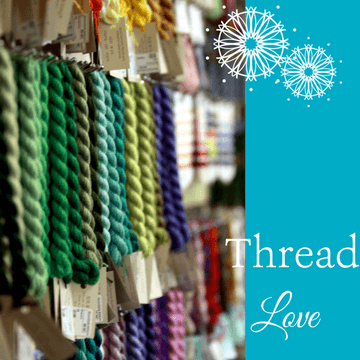
Are you a thread-aholic? Unashamedly, I confess that I am. There — I admit it, so I can tell you the whole truth. I have A LOT of thread — in fact, I probably don’t need to buy another single skein (ever!) — except, it’s just sooooo pretty and I might really need it for that canvas I stashed away a couple of years ago…
And it’s true! You really might need that beautiful skein of over-dyed silk, but before you begin choosing threads to stitch your canvas, there are several things to consider. Below are a few questions you really should ask yourself first.
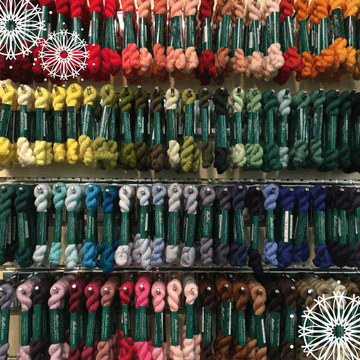
What’s the purpose of the item?
Is it functional or decorative? Will it be worn or displayed? Who is it for? How do you think that person will use it? If it’s a pillow for a child’s room, you should choose threads that are more durable than those you might select for a bolster for the living room sofa. And you can use all kinds of silky, sparkly threads on a Christmas ornament that you shouldn’t use on a belt.
Ask yourself what qualities you’re looking for in your finished project. Does it need to be washable/machine washable; durable; delicate; textured; silky; light-colored; neutral in color; dark-colored, glittery; plain? Will it be framed and hung on the wall or will it get a lot of use (like a pillow for the family room sofa!)? Once you determine the item’s purpose, you’ll be better equipped to make decisions about the fiber content and texture of the thread, and last, but not least, color (my favorite part!).
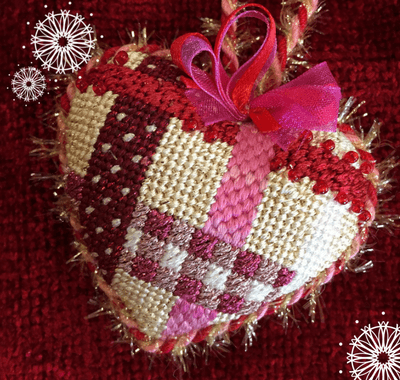
What kind of fiber should I use?
First, check the label to see what the thread is made of. Some threads contain a combination of fibers, making the decision a little trickier, but we’ll sort through it so you can make decisions with confidence. Generally speaking, there are four different kinds of needlepoint threads: wool, cotton, silk and novelty. Let’s take a closer look at each one now.
Wool Thread
Wool is, by far, the most popular type of thread used for needlepoint. It’s quite durable, making it the perfect choice for projects that will receive a lot of wear. A few of my favorites are Appleton (both tapestry and crewel wool), Bella Lusso, Planet Earth Wool, and Vineyard Wool. The beauty of Appleton tapestry wool, Planet Earth Wool, and Vineyard Wool is that they are designed to be used in single strands, which means that they’re really good for beginning stitchers. Appleton crewel wool and Bella Lusso are light-weight threads that lend themselves to blending colors and shading by using multiple strands threaded in the needle.
Cotton Thread
Cotton threads are quite durable, too, and they come in a plethora of colors. Perle cotton is particularly good for beginning stitchers, as it comes in a variety of sizes and is suitable for different mesh sizes. Six strand embroidery floss is the other cotton thread that can be used quite successfully in needlepoint, but it requires special treatment (stripping strands apart, putting them back together, and using a laying tool) in order to get it to lay down smoothly on your canvas. DMC is my “go-to” thread when I want to use a solid color of cotton thread on my canvas.
Silk Thread
Pure silk thread slides through your canvas like melted butter and it has a sheen that is unparalleled. Unfortunately, it’s not as durable as its wool and cotton counterparts, so you should really think about how the piece will be used before choosing silk thread. It’s also more costly than either cotton or wool thread. Silk thread is available in two main forms: twisted silk (like Pepperpot and Vineyard Silk) and plied silk (like Splendor and Soie d’Alger). Twisted silk behaves much like perle cotton and is easy to use. Plied silk, however, can be fly-away, so you have to use a lot of care when working with it. The strands will either tend to stick together — or you’ll find a straggler that wants to go its own way. Using a laying tool is an absolute necessity when working with plied silk.
Novelty Thread
Novelty threads add sparkle and dimension to your needlepoint canvas and they come in an assortment of textures and finishes: metallic, silky, fuzzy, velvety, prickly, sparkly, shiny, matte, etc. Each novelty thread has its own unique properties that require special handling in stitching. Rainbow Gallery and Kreinik threads are my favorites for adding bling and pizzazz to my needlepoint.
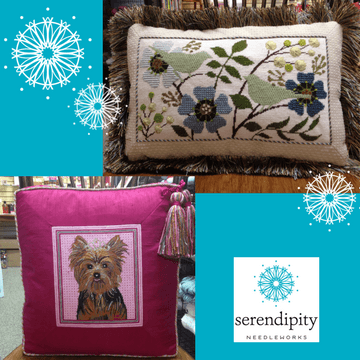
What weight thread should I use?
Deciding which threads will work best for your canvas is one of those things that you’ll get better at with practice. The most important thing to know is that thread weight correlates to mesh size.
The weight (which can also be thought of as thickness) of your thread should be such that it slides easily through the hole in the canvas. There are several different sizes of canvas mesh, but the most commonly used today are #10, #13, and #18. (We’ll keep things simple here and assume you’re working a basic needlepoint tent stitch on mono-canvas.) Generally speaking, smaller threads work best on smaller mesh and thicker threads work best on larger mesh. You want to be sure that you don’t have to tug to pull your threaded needle through the canvas, but you also don’t want to be able to see canvas peeking through your work. If either happens, you need to re-evaluate your thread choice. The exception to this (isn’t there always an exception?!) is with novelty threads. Some novelty threads create “drag” when being pulled through the canvas simply by virtue of their texture. When in doubt about whether or not a thread will work on a particular piece, you can always do a small test out on the edge of the canvas. (And be sure to keep an eye out here on the blog for more hints and tips coming soon!)
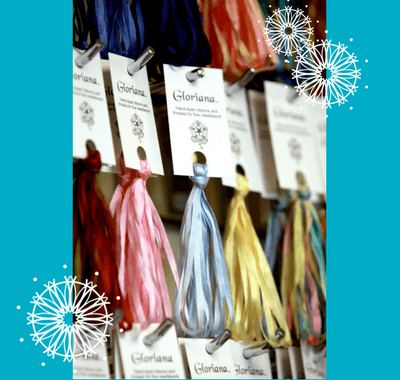
What texture should my threads be?
Your choice of thread texture can make — or break — the overall aesthetic of your finished piece. In my opinion, you can’t go wrong stitching an entire canvas in tent stitch using wool, cotton, or silk threads. Your finished piece will be a classic, traditional heirloom that you and your family will treasure for many years.
Novelty threads allow you to experiment and have fun with texture. The addition of novelty threads can (and should) enhance your piece with just the right touch of sparkle and pizzazz. A word of warning, though — be careful not to over do it with those funky fibers. The result can be a shockingly obnoxious mess.
Finding a happy medium — one where you use both natural fibers and novelty threads — is your ultimate goal. My best suggestion for using those novelty threads? Look at the design element on your piece, think about what texture that item has in the real world, then try and find a thread texture that mimics it.
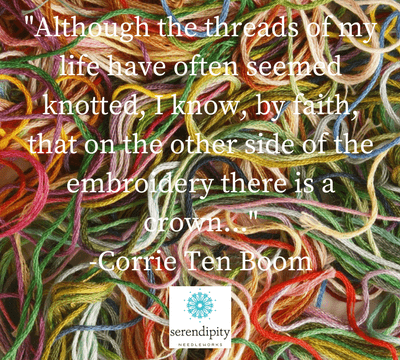
What color threads should I choose?
Now we’re finally to my favorite part of choosing threads for a project — COLOR!!!
Color can be overwhelming — especially when choosing threads for a needlepoint canvas. Hand-painted needlepoint canvases can be quite pricey, as can the threads. And there’s nothing more disheartening than to invest a lot of money into a project that you don’t like because you botched picking out colors. (Been there — done that!) Unless you’re familiar with color theory, I suggest that you match your threads to the colors of the paint on the canvas. (Remember, the artist has already chosen colors that play well together.) If you can’t find a perfect match for a particular part of the design, find one that’s as close as possible, then make sure it looks good with the other threads you’ve already selected.
Changing Colors
Sometimes the colors in an otherwise lovely canvas don’t match your decor. And then, there’s the canvas that you L-O-V-E…but it has that awful putrid green that you just can’t stand! (I know — you bought it anyway and now, you don’t know what to do. Been there — done that, too!) It’s quite acceptable to adjust colors on a canvas.
Just. Be. Careful.
Changing all of the colors on a piece can, sometimes, ruin the overall design. It’s usually better to change a few that might be glaringly out of place in your decor. You can always tone down a couple of colors here and brighten up a few colors there. If you’re not sure, you can always send me a note. I’ll be happy to share my suggestions.
After you choose your colors, be sure you get enough thread — in the same dye lot — to complete your project.
I’d love to hear from you, so please share your thoughts in the comment box below! Have a question? You can include it below, too. I read all of your comments and will be happy to help.


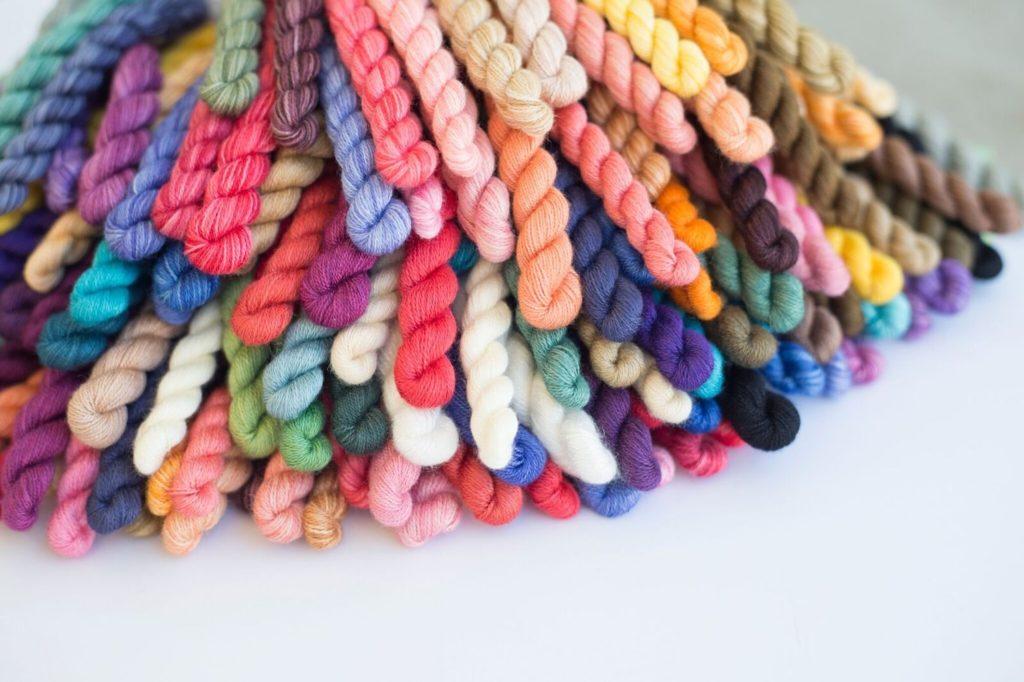
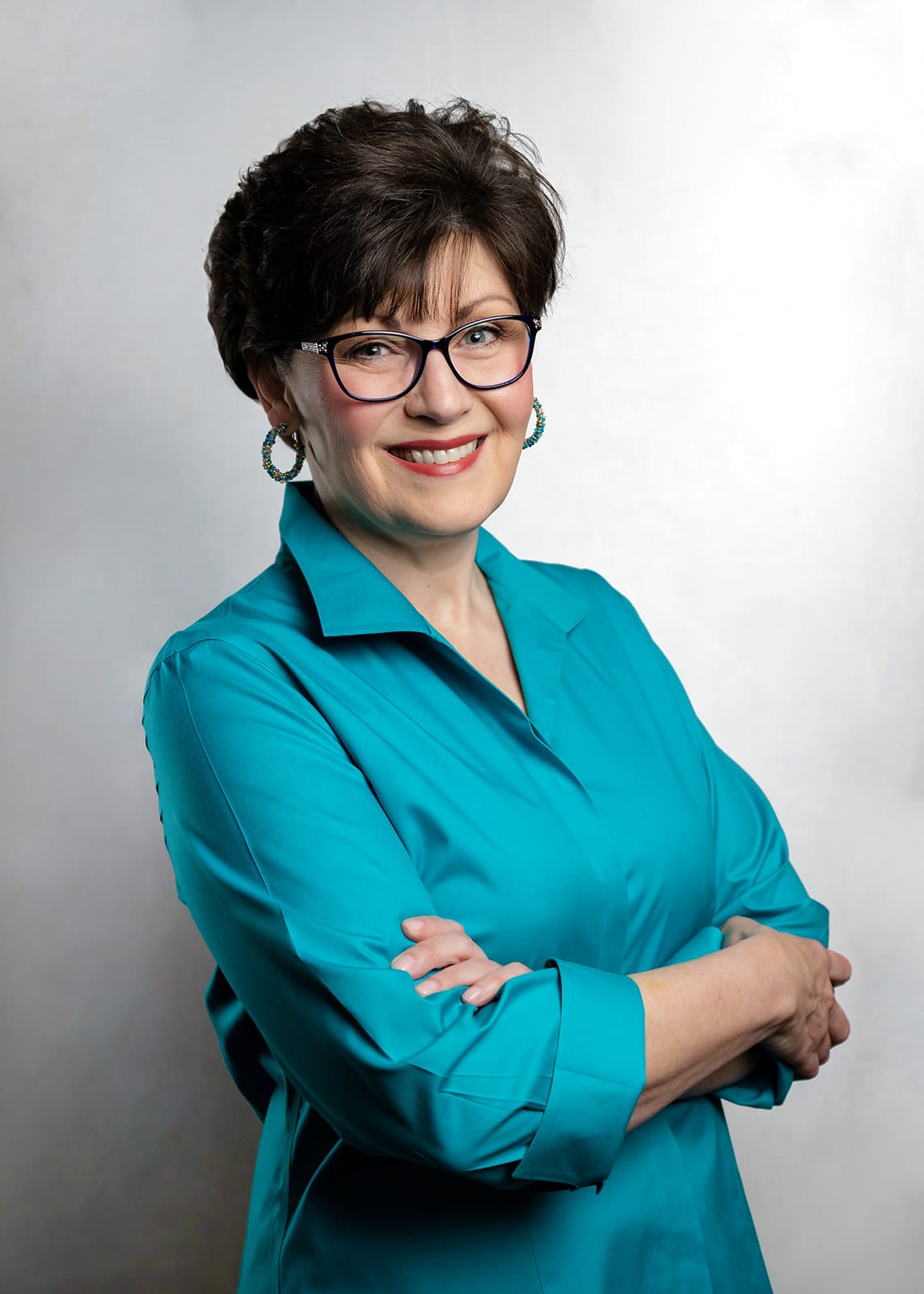

Thank you for sharing some things to consider before you choose what kind of thread to use. I will have to keep some of these things in mind as I start my next project like whether or not it will be machine washable. It’s good to know that wool thread is good for beginning stitchers.
Hi Gina!
Thank you for your note. I’m so glad you found the information helpful. Please feel free to reach out if you have any questions. I’m here to help!
XOXO!
Ellen 🙂
I’m a newbie to needlepoint and love it so far! I was confused at my local store when the lady was trying to tell me about thread choice for canvas size. She said if I use a 18 canvas mesh I need to use #5 Perle. If it use 10 or 13 I need to use silk ivory. Is this the case? I’d like to reuse threads I have with new canvases if I can and not buy new every time. Can you please explain?
Hi Cara!
Thank you for writing. The lady at your local shop was right about using #5 Perle cotton on 18 mesh canvas and Silk and Ivory on 13 mesh canvas. There are lots of other options, too, though. I have a blog post that includes a list of threads that can be easily used on 13 and 18 mesh canvas. My best suggestion is to start there – and if you have some threads in your stash that aren’t mentioned in my blog post, please feel free to come back here and ask about them. I’ll be glad to help.
Have a wonderful Wednesday…
XOXO!
Ellen
Is it advisable to use different. Threads on a canvas, wool for part perhaps cotton for small detail?
Hi Marlene!
You can absolutely mix thread types on a single canvas. I consistently use silk, novelty threads, metallics, and wool threads on the same design all the time. It can create very interesting textural differences. 😊
Happy stitching!!
XOXO!
Ellen
As a writer and a needlepoint stitcher, I am impressed by the care you take (and the time it takes you to write these posts) in order to communicate so clearly about this area of your expertise. I appreciate and benefit from every post I have read. Thank you for being so generous with your knowledge, sharing information and your passion for all things needlepoint.
Awwww…Carol, thank you so much for your kind words. ☺️ You just made my day!!! It makes my heart happy to know that you’re enjoying my posts (and learning from them, too!). It’s an honor to be able to share my knowledge with other stitchers, like you and I appreciate you taking the time to read my blog.
Have a great day and happy stitching!
XOXO!
Ellen❤️
HI: Would you recommend a few online sites for high quality needlepoint materials, canvases, fibers, etc.? I am unfortunately in an area that doesn’t have any specialty stores that sell the high quality needlepoint supplies. Thank you, Carol
Hi Carol!
Thank you so much for taking the time to write. My best suggestion for shopping online is to work with Stitches by the Sea in Delray Beach, Florida. I’ve ordered from them and had really good luck.
Happy stitching!
XOXO!
Ellen 🙂
I have decided to return to needlepoint after 45 years, and I am stunned at the current costs involved for this genre! How can I lean into some projects that won’t necessarily bankrupt me. I have six Grandchildren, and I would be delighted to create something special for each one.
Cheers,
Donita Leatherwood
Hi Donita!
Thank you for taking the time to write. My best suggestion is to look into counted canvas embroidery/needlepoint. There are some lovely designs available that won’t break the bank. Needle Delights Originals by Kathy Rees would be a good place to start. 🙂
Please reach out if you have questions. I’m happy to help!
XOXO!
Ellen
Thank you for this information. I am 70 years old. I spent 2 years with no memory and have had 1 year with my memory back. My liver was 100% dead. When that happens it draws on your kidneys and mine were 80% gone. God made a miracle for me. Today I am doing so good. I am alive and feel great. I have done needlework before and have always enjoyed it. So I have ordered a piece from Herrschners, Guardian Angel, in needlepoint, first time ever in needlepoint I will need to order the thread myself. I found you online and I love how you explain everything. Thank you !
Hi there, Allene!
Thank you so much for taking the time to write. I’m delighted that you found me and I sincerely appreciate your kind words.
I’m so happy that you’re trying your hand at needlepoint. I think you’re going to LOVE it! Of course, I may be a little partial. 😉
Please reach out if you have any questions. I’m happy to help.
And God is truly wonderful, isn’t He? Such a blessing you’ve received – and I’ve received one, too, through your sharing of it with me here.
Sending you lots of love and a great big hug!
XOXO!
Ellen
This was extremely helpful and easy to understand as a new stitcher! My first canvas came with threads and I just got a couple canvases that did not come with anything. I have been going crazy trying to figure out what to do! They are all different mesh size also. So thankful to have found this post! Do you have any recommendations for a frame or stretcher bars? The canvases are not finished around the edges at all. Thanks!
Hi Rachel!
Thank you so much for your kind words. I’m tickled to hear that you found the post helpful. 🙂
I prefer using stretcher bars for smaller projects – anything smaller than 15″ x 15″. I like scroll frames for larger projects. I also recommend that you bind the edges of your canvases. My preference is to use artist’s tape. You can find it at art supply stores or on Amazon.
Let me know if you have any questions. I’m happy to help!
XOXO!
Ellen
I have a question about having so many threads, how do you keep them? Over time don’t the threads get weaker? Is there a recommendation as to where to store threads? the market has different methods.
Hi Katherine!
You have a great question! It’s one of the quintessential questions that all people who do any form of needlework for a hobby have. I wish I had to “one size fits all” answer, but, alas, I don’t. My best suggestion is to catalog your threads by fiber type. You can use a Google spreadsheet or you can print out a blank table and fill it in by hand – whichever works best for you. I keep my threads organized by color, using the color wheel as my guide. Threads generally won’t weaken to the point that they’re not usable during one’s lifetime unless they’re not stored properly. It’s best to keep your threads in a cool, dry, dark place (e.g., a closet in your home). I hope this helps. 🙂
Have a happy Wednesday!!
XOXO!
Ellen
PS: We cover a lot of this info in the Thread Talk section of The Stitcher’s Club, too. 😉
Hi Ellen,
Thank you on behalf of all newbies and needlepoint folks for you wonderful resource blog and great posts!
I am working on my first project with silk Vineyard classic. The colors were picked from the shop I purchased the painted canvas by wonderful experts. I live in another area and its a distance. I have Cerulean #C-95 and Gloxinia #C-099 for a witch dress. I am trying to figure out how to blend threads for the transition shades in the dress. As a third blending color was not picked, am I not to blend the colors? Its a big jump to my eye, but its my first project and I just have no experience.
Thank you so much for your time….Hugs, Teri
Hi Teri!
Thank you so much for your sweet note – and for your kind words about my website. 🙂
I don’t have the actual skeins of thread in front of me, but in looking at the Vineyard Silk website, there appears to be a color in between (098 – Deep Wisteria) that could be a good transition between the Cerulean and Gloxinia. I hope this helps…
XOXO!
Ellen
I was so glad to find your website! I have taken up needlepoint again after 30 years and love it but my problem is finding the right yarn. Some of my canvases came with yarn ( 3 ply Persian wool) but I’d like to soften a few of the colors. I have looked locally but no one is familiar with needlepoint . Any suggestions on what I should buy to complete my project?
Hi Paige
I’m tickled to learn that you’re picking your needlepoint up again! My friend, Saira, owns Chandail Needlework in Houston, TX and she helps stitchers from around the US with acquiring threads for their projects. My best suggestion is to reach out to her. Here’s her website: https://www.chandailneedlepoint.com/
She carries oodles of different threads and I’m sure she can help you with substituting some of the colors on your canvas with a thread that will work with what you already have. 🙂
Happy stitching…
XOXO!
Ellen
Your website is wonderful! I have learned so much!
Which white fibers are better for stitching the top of a #18 canvas Christmas stocking where a name is added? Would you recommend combining fibers such as Whisper and #16DMC to give a touch of furry effect?
Hi Eve
Thank you so much for your sweet note! I appreciate your kind words more than you’ll ever know – and I’m tickled that you’ve found the info helpful. If you’d like to get a fuzzy effect, you can definitely add Wisper to another thread. My favorite combination is actually Bella Lusso + Wisper. When working on 18 mesh canvas, you’ll want to do a little bit of testing in the border to see what looks best. Try starting with 2 strands of Bella Lusso and 1 strand of Wisper. If that looks too thin, add another strand of Bella Lusso. Hope that helps… and happy stitching!!
XOXO!
Ellen
Hi Ellen,
You are a godsend to me. I did a needlepoint project once 25yrs ago.
I am a little overwhelmed but your tips are getting me through. I am making a 4″ solid colored heart. I would like to use silk thread. The canvas is 14pt. I am still confused as to how much thread to get. Any assistance would be greatly appreciated!
Thanks,
Melinda Winters
Hi Melinda
Thank you for your kind note. I’m happy to help. If you plan to use a thread like Planet Earth Silk (a single strand thread), then you should be safe with one skein. If you’re using a divisible thread like Splendor, then one card ought to do the trick. Keep in mind, though, that some decorative stitches are thread hogs, which means they require a LOT of thread. If the stitch you’re using is one of those, then I recommend getting a second skein/card just to be on the safe side. 😉
Happy stitching!!
XOXO!
Ellen
Hi Ellen, I purchased a needlepoint design while on vacation a few weeks ago. I’ve done lots of crochet and counted cross stitch over the years. I haven’t ever done needlepoint. It’s a Christmas design with only 7 or8 colors. I bought some size 3 pearl cotton but it seems too heavy. It’s just a bit tough to pull through and it’s not laying nicely. I need recommendations for other threads. The canvas isn’t marked but I think it’s 13 count. Please help!
Marilyn
Hi Marilyn!
It’s so nice to hear from you – and welcome to the wonderful world of needlepoint. 🙂
You’re gonna L-O-V-E it!! I’m happy to help with your thread dilemma.
Pearl cotton #3 can be a little finicky to work with – and it often doesn’t lay smoothly on your canvas. My best suggestion for 13/14 count canvas is Silk and Ivory. It’s a 50% silk/50% wool thread that is dreamy to work with. Once you use it, you’ll be “hooked”. 😉
Sending happy stitching thoughts your way…
XOXO!
Ellen
Hi
I don’t do X stitch but I do like to stitch needlepoint. I have seen a pre-printed cross stitch canvas which says it is 11CT – and it provides what I think are DMC silks. Do you know what tapestry wool would work instead of the silks (Appletons perhaps?) and if DMC have a colour coding for wool which matches or roughly matches their colour coding for silks.
I think that there must be others who see X stitch kits that they would like to stitch in wool so I hope that if you are able to reply this will be of general interest.
Thank you for all your super information
Chris
Hi Chris!
Thank you for your kind words about my website. I’m happy to help with your question… there’s actually a PDF that you can download here. It’s a conversion chart for DMC embroidery floss to Appleton Crewel wool colors. The crewel weight wool and tapestry weight wool color numbers are the same. I hope this helps…
Happy Stitching!
Ellen
I’m doing an 18 mesh needlepoint heart design to put on the back of my granddaughters jean jacket sz 5-6. My question is which threads I could use that could be washed. If that isn’t possible, do you have any experience finishing clothing items where the canvas part can be removed for cleaning? Love your site!!
Hi Lynne
Thank you for your kind words about my website. 🙂
Perle cotton is washable and would be a good option for your granddaughter’s jacket. You could also use DMC cotton embroidery floss.
Hope this helps – and happy stitching!!
XOXO!
Ellen 🙂
What is the finest and most beautiful thread? If cost was no object, what is the most beautiful type of thread and why?
Hi Andrea
You have an interesting question. Honestly, I don’t think I can choose just one, even if money weren’t an issue. So much depends upon what kind of needlework you’re doing. If doing needlepoint and I could only use one kind of thread, though, I would choose stranded silk. I’d likely opt for Soie d’Alger because it stitches up so beautifully and the color palette is amazing.
Have a terrific rest of your day and happy stitching!!
XOXO!
Ellen
Hi, like many other commentors, I too am taking on a needlepoint project after quite a lengthy hiatus. I’m no expert but certainly not everyone can be. I enjoy it all the same. Have managed to get through a couple of decent sized William Morris projects. I’m in a quandry over my choice of tapestry yarn. I’ve priced out my project and determined, Appleton’s (mostly hanks) to be approx. $420cdn , DMC $300cdn. I’m worn out researching which might be the better quality yarn. Perhaps the difference isnt even discernable? I do admit, I would sooner pay more for a better product given this may take me a year or more to complete. This project is an Elizabeth Bradley needlepoint on 12 count canvas, half cross stitch, 25″x38″. Also, I’m still seeking out canvas by the yard in brown and in Canada. A bit sad how needlepoint and many crafts have fallen out of favor. The absolute beauty of some very old pieces I’ve acquired puts me in awe of the craftspersons patience and skill. Thank you, Brenda, Nova Scotia, Canada
Hi Brenda!
It’s so nice to hear from you. Congratulations on your finishes of the William Morris pieces. I’m a HUGE William Morris fan!!
Regarding your new project, I understand your dilemma and am happy to help. My preference for the EB project you are undertaking is Appleton wool. You might check with Cindy’s Needle Art in Richmond Hill, Ontario for the canvas. I’m not certain they have it, but they have a large mail order department. If they don’t have what you need, they may be able to direct you to someone who does.
Wishing you all the best with your new project… and keep me posted on your progress, if it’s not too much trouble. 😉
XOXO!
Ellen
As always, I learn something new from your needlepoint tips/tricks/strategies/guide. As a retired teacher/librarian, I appreciate the clarity of your descriptions. Thank you so much; you are mahvelous, dahlin’! ♥️🪡
Hi Minta!
Thank you so much for your kind words! I’m tickled to know that you found the guide helpful.
Have a wonderful rest of your day – and please stop by for another “visit” soon.
XOXO!
Ellen